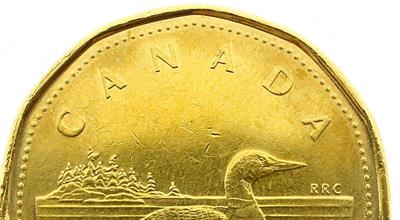The Loonie
Jul 01, 2016
 In 1987, the Royal Canadian Mint produced a small, gold-colored coin (actually, it is currently made of steel with brass plating) to replace our paper one dollar bill. On the first issue of the coin, there was a loon, which is a common bird in Canada. Canadians quite quickly began to refer to the coin as “the loonie”. Many people thought the name “loonie” was cute and funny and, in a way, a good description of how some other countries viewed our currency. Twenty-nine years later, we still use the term loonie and have also adopted the term toonie for the two dollar coin.
In 1987, the Royal Canadian Mint produced a small, gold-colored coin (actually, it is currently made of steel with brass plating) to replace our paper one dollar bill. On the first issue of the coin, there was a loon, which is a common bird in Canada. Canadians quite quickly began to refer to the coin as “the loonie”. Many people thought the name “loonie” was cute and funny and, in a way, a good description of how some other countries viewed our currency. Twenty-nine years later, we still use the term loonie and have also adopted the term toonie for the two dollar coin.Back in 1987, the loonie was worth about 75 cents vs. the United States Dollar. Interestingly, it is worth about the same today. However… between 1987 and now, the Canadian Dollar has gone for a quite a ride. We have seen various highs and lows. In 2007, our dollar was very close to $1.10 vs. the US dollar. At the same time, oil was approaching an all-time high. Predicting the future value of our dollar is a very difficult endeavor as it is based on multiple, different, equally hard-to-predict factors.
While the trading history of the dollar is interesting, we become acutely aware of it when we are planning a trip or making a purchase on Amazon.com. What many people do not realize is that the value of the loonie vs. other currencies can both add to and subtract from the returns in your investment portfolio.
Diversification is a very important factor in creating a successful investment portfolio. To achieve diversification, most Canadians invest some of their portfolios in markets outside of Canada. When doing this, we are buying investments that are denominated in foreign currencies. For example, when a Canadian mutual fund invests in US stocks, they first have to convert Canadian dollars to US dollars. When the US dollar rises relative to the Canadian dollar, the exchange rate will add to your returns. Conversely, if the Canadian dollar rises vs. the US dollar, you will experience losses based on currency movement. Regardless of how the underlying stocks in the portfolio perform, you can experience gains and loses just based on currency fluctuations.
Many people argue that, over the long run, currency balances itself out. As an example, twenty-nine years ago, when the loonie was first issued, the Canadian dollar was worth about the same as it is today. There are ways of mitigating currency fluctuations. Some mutual funds employ hedging techniques. While this can be a valuable tool, sometimes it can work against you. In the last few years, using hedging strategies has worked against many investors. That being said, there are time periods where hedging currency has added to net investment returns.
Your Rogers Group Financial Advisor takes these issues into consideration when building portfolios based on your goals and risk tolerance. It’s just one part of the complicated process of making sure that each client portfolio is invested suitably for each client situation.
You might also be interested in...
Business Owners
The most overlooked area of financial planning for business owners and incorporated professionals is the lack of integration between corporate and personal assets. When the majority of your assets are in your corporation you need very specific, specialized and personalized financial advice.
Learn More
Popular Categories
Search Insights
Book a meeting
Schedule a meeting with an RGF Advisor.







